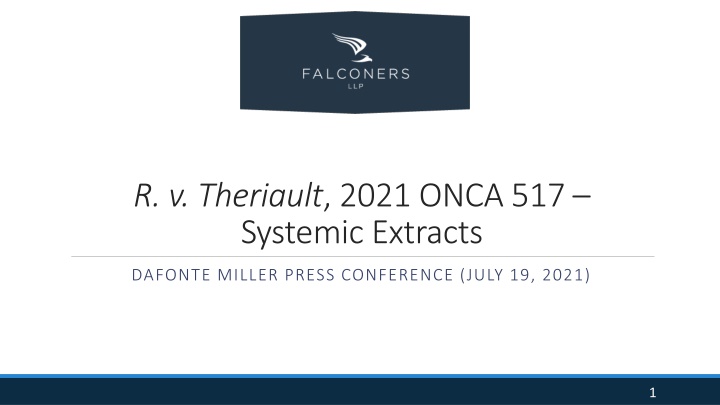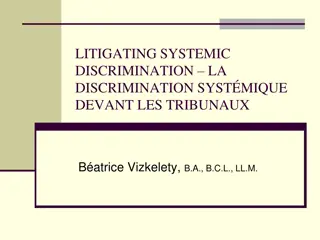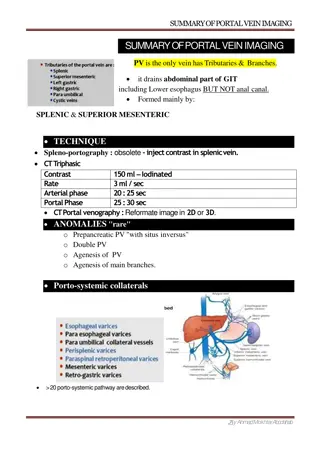
Systemic Racism in Canadian Criminal Justice System
Explore the impact of anti-Black racism in the Canadian criminal justice system, as highlighted in the case of R. v. Theriault, discussing how social context influences interactions with law enforcement and the importance of considering systemic racism in judicial decisions.
Download Presentation

Please find below an Image/Link to download the presentation.
The content on the website is provided AS IS for your information and personal use only. It may not be sold, licensed, or shared on other websites without obtaining consent from the author. If you encounter any issues during the download, it is possible that the publisher has removed the file from their server.
You are allowed to download the files provided on this website for personal or commercial use, subject to the condition that they are used lawfully. All files are the property of their respective owners.
The content on the website is provided AS IS for your information and personal use only. It may not be sold, licensed, or shared on other websites without obtaining consent from the author.
E N D
Presentation Transcript
R. v. Theriault, 2021 ONCA 517 Systemic Extracts DAFONTE MILLER PRESS CONFERENCE (JULY 19, 2021) 1
[143] The existence of anti-Black racism in Canadian society is beyond reasonable dispute and is properly the subject matter of judicial notice. It is well recognized that criminal justice institutions do not treat racialized groups equally: Robin T. Fitzgerald and Peter J. Carrington, Disproportionate Minority Contact in Canada: Police and Visible Minority Youth (2011) 53 Can. J. Crimin. & Crim. Just. 449, at p. 450; R. v. Le, 2019 SCC 34, 375 C.C.C. (3d) 431. This reality may inform the conduct of any racialized person when interacting with the police, regardless of whether they are the accused or the complainant. 2
[144] The social context of anti-Black racism was relevant in the case at hand. I agree with the trial judge that it would have been understandable for Mr. Miller to distrust law enforcement. When police arrived on the scene, Mr. Miller was severely injured; he was bleeding profusely from his face and unable to stand on his own. The Theriault brothers had no visible injuries, except for a scratch on Christian s hand. Yet, police permitted Michael to handcuff and search the severely injured Mr. Miller. The trial judge was right to point out that the matter may have unfolded differently had the first responders arrived at a call late one winter evening and observed a black man dressed in socks with no shoes, claiming to be a police officer, asking for handcuffs while kneeling on top of a significantly injured white man. Mr. Miller s charges were not stayed until months later. 3
[145] The trial judge was correct to consider the social context of anti-Black racism, and its effect on Mr. Miller s actions and how he was treated on the night in question. It is common sense that being a Black man in our society could have affected Mr. Miller s trust in law enforcement and the criminal justice system more broadly. [146] In my view, it is incumbent on trial judges to consider relevant social context, such as systemic racism, when making credibility assessments. The trial judge did not err in doing so, and his findings are entitled to considerable deference on appeal. 4
[212] While often overlooked out of a tendency to distance ourselves from the social ills plaguing our southern neighbour, Canada s long history of anti-Black racism has manifested in the contemporary phenomena of over-policing and disproportionate incidents of violence during interactions between Black people and the police: Le, at para. 93. Systemic and overt racism have long sustained unequal treatment before the law, leading to a crisis of confidence in the administration of justice in some communities. The current moment of reckoning with respect to systemic racism in Canada is long overdue. 5
[213] As the trial judge put it, Michaels conduct further sowed the seeds of distrust between the Black community and the police. Michael s actions, as a white off-duty police officer who assaulted a retreating, injured Black youth, cannot, and should not, be divorced from this wider context. As noted above, Michael was a representative of the rule of law in this country, and his actions shattered a community s trust in the very system that is supposed to protect them. [214] Mr. Miller may have broken the law that night, but he did not deserve what subsequently happened to him. The right to be free from excessive and unreasonable force does not discriminate. 6
[215] The trial judges treatment of this larger context in sentencing was laudable and sets a model for future cases of this nature. As I will explain, he did not falter in his role of imposing an individualized and proportionate sentence, while also recognizing that this type of crime warrants heightened denunciation due to its devastating implications. 7
[218] The trial judge correctly concluded that this case called for heightened denunciation and I endorse his approach. As our society comes to grips with disproportionate rates of police violence against Black people, it is integral that the need for denunciation of crimes that are emblematic of these broader social patterns develops accordingly. 8
Miigwetch! Thank You Litigation with a conscience. Main Office: 10 Alcorn Avenue, Suite 204, Toronto ON M4V 3A9 Phone: (416) 964-0495 Fax: (416) 929-8179 Northern Office: 104 Syndicate Avenue North, Suite 200, Thunder Bay, ON P7C 3V7 Phone: (807) 622-4900 Fax: (416) 929-8179 9






















